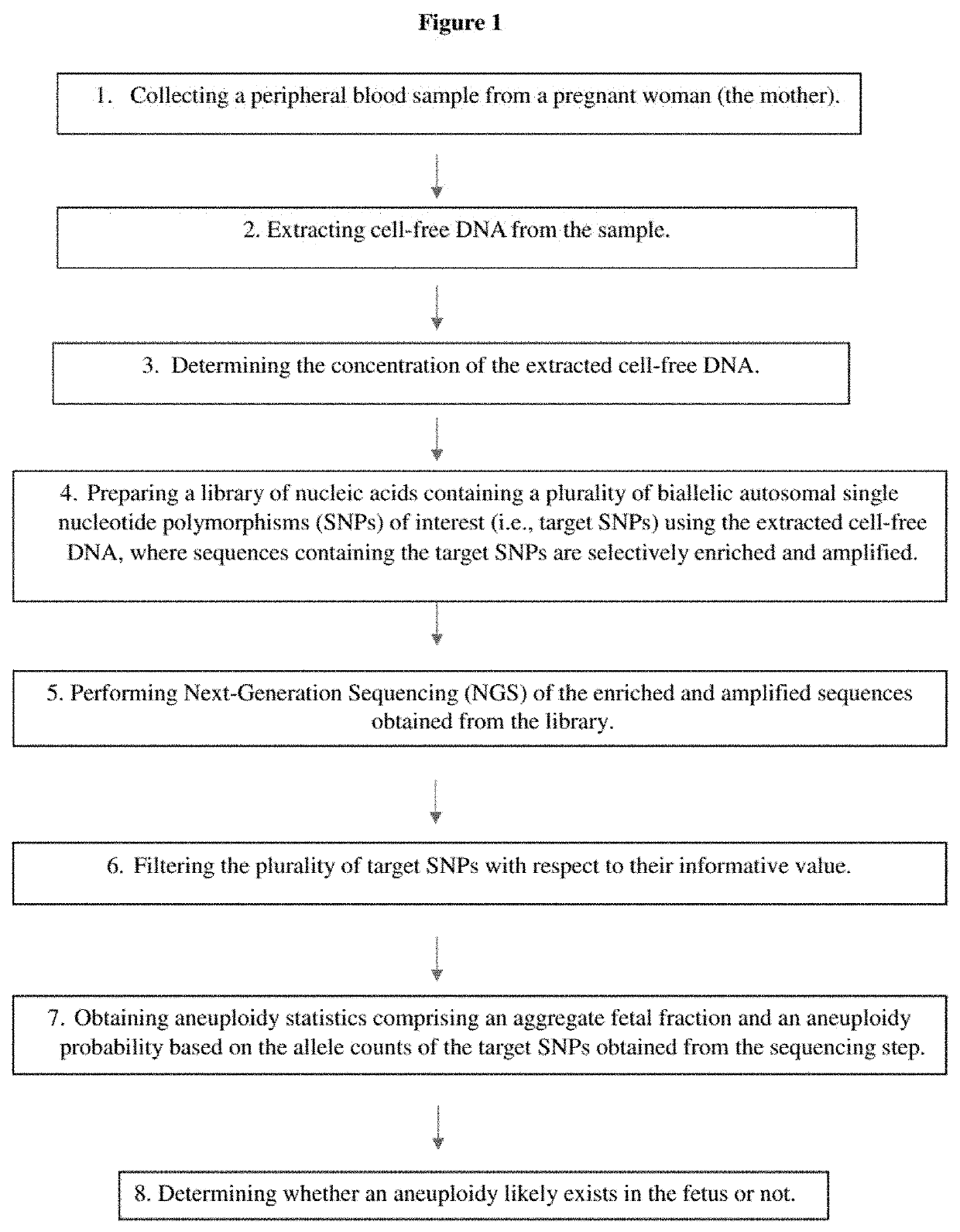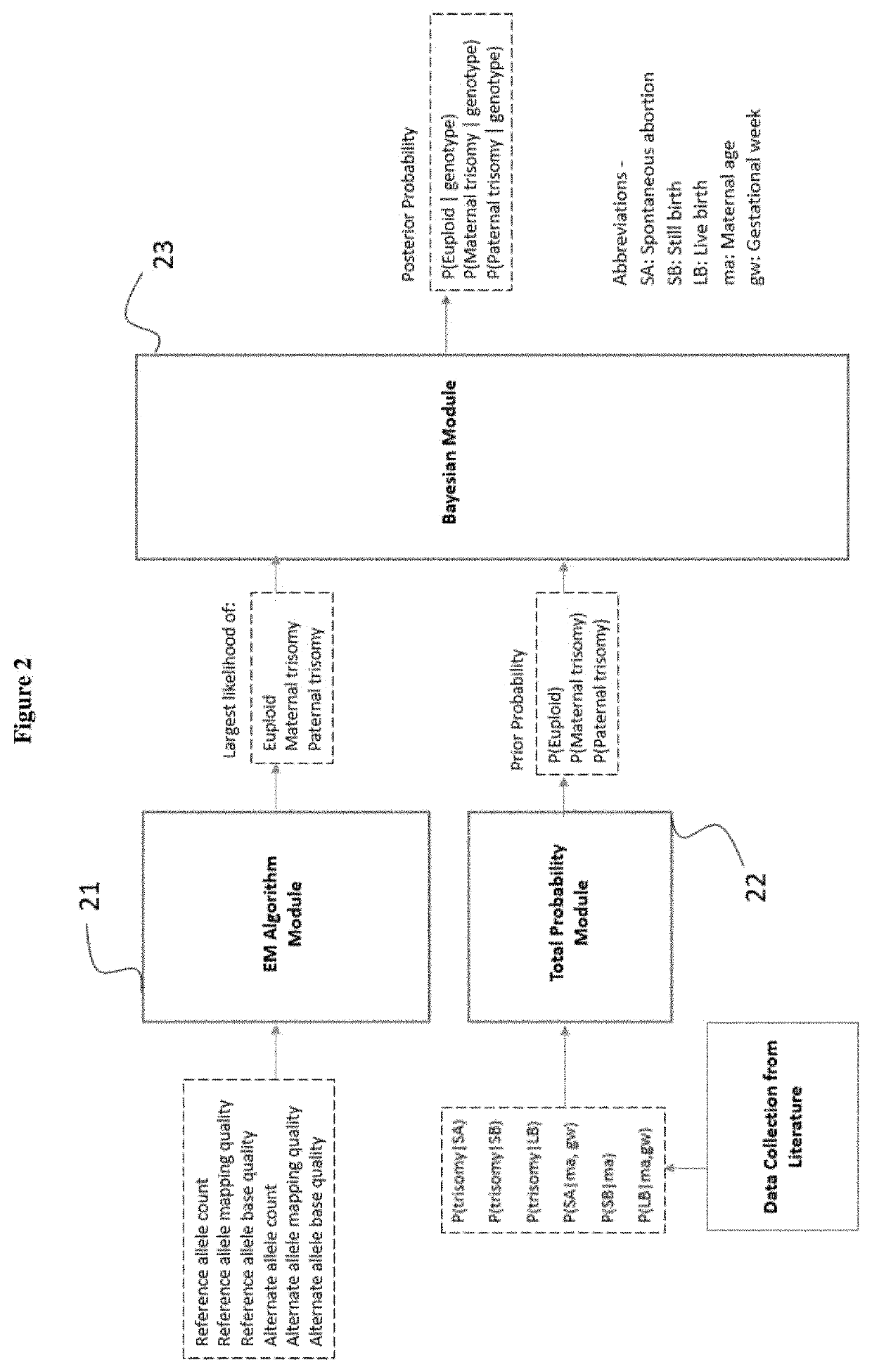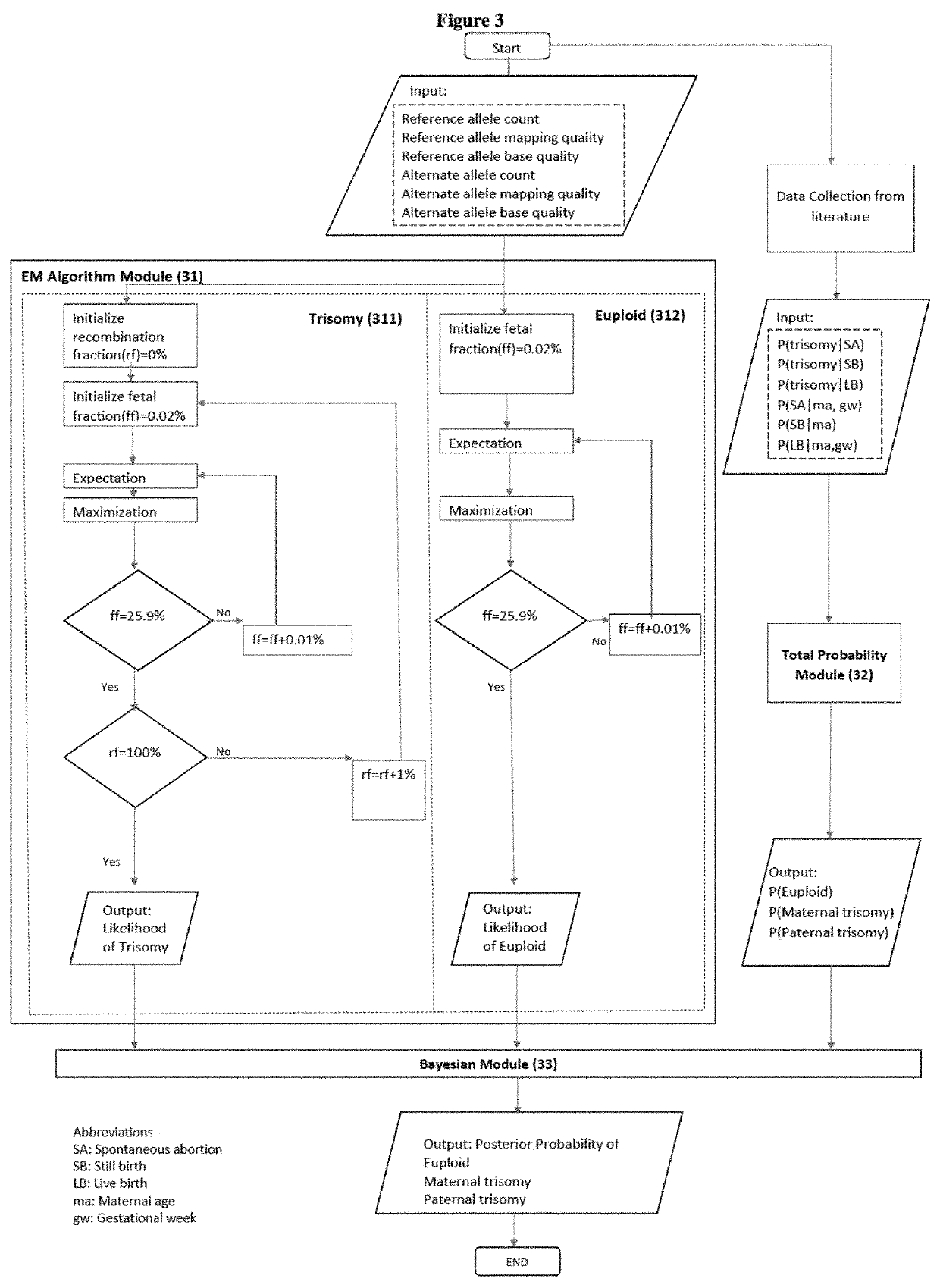Methods for non-invasive prenatal determination of aneuploidy using targeted next generation sequencing of biallelic snps
a technology of biallelic snps and prenatal determination, which is applied in the field of non-invasive prenatal testing, can solve the problems of wgs taking a longer time to acquire the required genotype data, the risk of womb and carrying 1-2% miscarriage, and the need for highly delicate and sensitive means
- Summary
- Abstract
- Description
- Claims
- Application Information
AI Technical Summary
Benefits of technology
Problems solved by technology
Method used
Image
Examples
example
[0181]Let Di to be trisomy T21,
ValuesParametersP(T21|SA)3.19%P(SA|ma, gw) 15%P(T21|SB)9.21%P(SB|ma, gw) = P(SB|ma) 15%P(T21|LB)0.05%LikelihoodNon-trisomy 21 fetuse−206221Maternal trisomy 21e−206209Paternal trisomy 21e−206271
P(T21ma,gw)=P(T21SA)P(SAma,gw)+P(T21SB)P(SBma,gw)+P(T21LB)P(SBma,gw)=P(T21SA)P(SAma,gw)+P(T21SB)P(SBma)+P(T21LB)(1-P(SBma,gw)-P(SBma))
[0182]By substituting the values, P(T21)=0.01895.
[0183]According to the equation for P(Di|G),
P(maternaltrisomygenotype)=e-206209e-206221×0.01895×0.9034(1-0.01895)+e-206209e-206221×0.01895×0.9034+e-206271e-206221×0.01895×0.0966
[0184]The ratios of trisomies (i.e., 0.9034 and 0.0966) are provided according to Table 9 in this document. The value 0.01895 is the probability of T21.
[0185]In one embodiment, the method determines whether the fetus in question has aneuploidy by comparing the determined probability of aneuploidy and a cutoff value which produces a pre-determined sensitivity. In one embodiment, a cut-off value of 90% gives r...
example 1
Sample Preparation—Purification of Cell-Free DNA from Maternal Blood or Plasma Sample
[0188]This example illustrates one embodiment of extraction of cell-free DNA from maternal whole blood or plasma sample using Promega Maxwell® Rapid Sample Concentrator (RSC) and determination of the concentration of the extracted genomic DNA using Qubit® Fluorometer.
[0189]10 mL whole blood sample was collected from a pregnant subject and stored in cfDNA blood tube. The sample was then processed according to the following protocols:
[0190]Preparing Plasma[0191]1. Centrifuge the whole blood from cfDNA blood tubes at 3000 rpm for 5 min.[0192]2. Aliquot out all the plasma and centrifuge the collected plasma at 14000 rpm for 10 min. 3. Collect and store the supernatant in a new 2 mL screw cap tube at 4° C. until further use, or −20° C. for long-term storage.
[0193]Binding of Circulating Nucleic Acid to Magnetic Resin[0194]1. Add 2 mL of binding buffer to a 50 mL falcon tube.
[0195]2. Add 140 μL of magnetic...
example 2
Library Preparation for Target Enrichment—Protocols for Hybridization-Based Approach
[0239]In the present invention, hybridization-based library preparation builds on the SeqCap manufacturer's protocol. In the following protocols and procedures, slight differences from the manufacturer's version are introduced to customize and optimize the workflow so as to achieve better sequence readings in the later stages.
[0240]The procedures comprise fragmentation, end repair and A-tailing of DNA, adapter ligation, library amplification (i.e., pre-enrichment amplification), post-amplification cleanup, sample hybridization with SeqCap Probe Pool (i.e., target enrichment) and post-hybridization amplification (i.e., post-enrichment amplification). Detailed protocols are as follows:
[0241]Optimized SeqCap EZ Workflow
A. Put the AMPure XP Beads at Room Temperature
[0242]B. Prepare DNA (1 ng-1 μg Recommended for Cell-Free DNA)[0243]1. Maximize volume-50 W plasma Input
C. End Repair and A-Tailing
[0244]Kit ...
PUM
| Property | Measurement | Unit |
|---|---|---|
| allele frequencies | aaaaa | aaaaa |
| concentration | aaaaa | aaaaa |
| frequencies | aaaaa | aaaaa |
Abstract
Description
Claims
Application Information
 Login to View More
Login to View More - R&D
- Intellectual Property
- Life Sciences
- Materials
- Tech Scout
- Unparalleled Data Quality
- Higher Quality Content
- 60% Fewer Hallucinations
Browse by: Latest US Patents, China's latest patents, Technical Efficacy Thesaurus, Application Domain, Technology Topic, Popular Technical Reports.
© 2025 PatSnap. All rights reserved.Legal|Privacy policy|Modern Slavery Act Transparency Statement|Sitemap|About US| Contact US: help@patsnap.com



